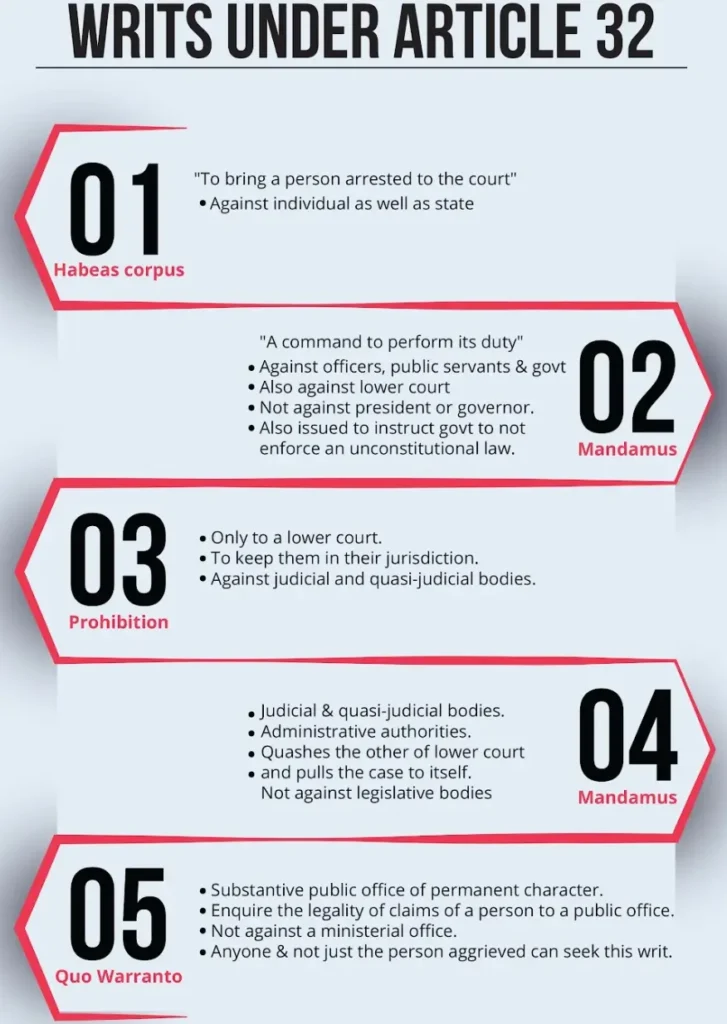- Introduction
- Article 32: Your Direct Access to the Supreme Court
- Public Interest Litigation (PIL): The People’s Voice
- Article 33: Special Provisions for Armed Forces
- Article 34: Martial Law and Its Implications
- Article 35: Legislative Powers to Protect Fundamental Rights
- Why Is This Right So Important?
- Conclusion
Introduction
The Right to Constitutional Remedies is like the backbone of democracy in India. It guarantees that if your fundamental rights, enshrined in the Constitution, are violated.
You have the right to approach the courts for justice. This right laid out in Articles 32 to 35, empowers individuals to ensure that their rights are protected and enforced. Let’s break it down in a conversational way and understand its nuances.
Article 32: Your Direct Access to the Supreme Court
Article 32 is often referred to as the “soul” of the Indian Constitution because it allows citizens to approach the Supreme Court directly when their fundamental rights are violated. The Supreme Court is not just there to hear your case—it has the power to issue specific types of orders (called writs) to protect your rights.

These writs include:
- Habeas Corpus: Used when someone is unlawfully detained.
- Mandamus: Directs a public official or government body to perform a duty.
- Prohibition: Prevents lower courts from exceeding their jurisdiction.
- Certiorari: Allows higher courts to review and correct the decisions of lower courts.
- Quo Warranto: Challenges a person holding public office without legal authority.
So, if you’re ever in a situation where your fundamental rights feel compromised, Article 32 ensures you have a swift legal route to justice.
Also Read: Right To Property in Constitution
Public Interest Litigation (PIL): The People’s Voice
One of the most impactful tools under Article 32 is Public Interest Litigation (PIL). This allows anyone, even if they are not directly affected, to approach the court on behalf of those who may not have the resources or ability to do so. This has been crucial in protecting the rights of the disadvantaged.
For example, in Bandhua Mukti Morcha v. Union of India, the Supreme Court took up the case to free bonded labourers. This case showed how the court can step in to address issues affecting large sections of society when others may be unable to raise their voice.
Article 33: Special Provisions for Armed Forces
While everyone in India enjoys fundamental rights, Article 33 allows the Parliament to make exceptions for the armed forces and other services tasked with maintaining public order and security. These exceptions ensure that discipline and duties are upheld without interference from rights that might otherwise disrupt military or security operations.
Article 34: Martial Law and Its Implications
Martial law isn’t something we hear about often, but when it is declared, Article 34 allows the Parliament to indemnify (protect) individuals who have taken actions to restore or maintain public order during that time. This is to ensure that those maintaining law and order aren’t unfairly punished for their actions during emergencies.
Article 35: Legislative Powers to Protect Fundamental Rights
Finally, Article 35 grants Parliament the exclusive power to make laws regarding the enforcement of certain fundamental rights. It ensures that laws that need to be made for specific purposes under Articles 16, 32, 33, and 34 are in the hands of the central government. This keeps the enforcement and protection of fundamental rights streamlined and consistent across the country.
Why Is This Right So Important?
Without the Right to Constitutional Remedies, the rest of the rights would be like an empty promise. It’s the enforcement mechanism that keeps the balance of power and ensures that no one—be it an individual, organization, or the government itself—can infringe upon your fundamental rights without facing the consequences. This makes it a true guardian of democracy.
The right also acts as a safety valve for the Indian citizenry. Anytime there is a violation of rights, this legal route ensures that justice can be sought without delay.
Conclusion
The Right to Constitutional Remedies (Articles 32-35) is a cornerstone of the Indian Constitution. It empowers every individual with the ability to seek justice, especially in cases of fundamental rights violations. From direct access to the Supreme Court to PILs that protect the disadvantaged, these provisions ensure that justice remains accessible and enforceable. The robust protection of fundamental rights is what keeps democracy strong and keeps the government accountable to its people.
If you ever feel that your rights are being violated, remember: the Constitution has your back.
FAQs
What is the Right to Constitutional Remedies?
The Right to Constitutional Remedies is the power given to individuals to approach the courts, particularly the Supreme Court, if their fundamental rights are violated. Under Article 32, the Supreme Court has the authority to issue writs to enforce these rights.
What are the different types of writs issued under Article 32?
The five main types of writs issued by the Supreme Court under Article 32 are:
- Habeas Corpus: To release someone unlawfully detained.
- Mandamus: To compel a public official to perform their duty.
- Prohibition: To stop a lower court from exceeding its jurisdiction.
- Certiorari: To review a lower court’s decision.
- Quo Warranto: To challenge the legality of a person holding public office.
What is Public Interest Litigation (PIL)?
Public Interest Litigation (PIL), moreover, allows any citizen, even if they are not personally affected, to approach the courts on behalf of marginalized or disadvantaged groups whose constitutional rights have been violated. Consequently, PILs ensure access to justice for those who may not be able to represent themselves.
Also Read: Cultural and Educational Rights
Reference: nextias.com